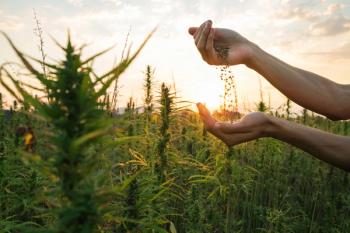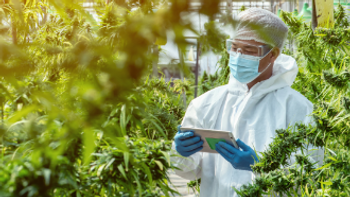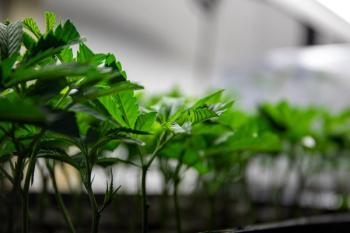
Cannabis Science and Technology
- July/August 2021
- Volume 4
- Issue 6
The Future of Nutrient Monitoring: How Plant Sap Analysis Can Help You Cultivate Healthier Plants for Less
Here we explore how extracting and analyzing plant sap can help growers make real-time decisions that lower their production costs and improve crop quality.
For decades, growers have used leaf tissue analysis to monitor nutrient uptake in their crops. The problem with this monitoring technique is that when we study leaf tissue samples, we are looking at the past. Deficiencies or toxicities can take weeks to manifest themselves in the plant, and once the problem is recognized and tissue samples are sent off to the laboratory, it’s often too late. Plant sap analysis solves this problem. Plant sap is the fluid that carries minerals and metabolites throughout the xylem and phloem of the plant. This article explores how extracting and analyzing this sap can help growers make real-time decisions that lower their production costs and improve crop quality.
When it comes to plant nutrition, cannabis growers can’t afford to guess. Nutrient deficiencies can result in decreased yields and sick plants, while excess fertilizer can cause nutrient lockout, increased pest problems, and higher production costs. A nutrient monitoring program is one way to ensure the health and productivity of a crop while avoiding the over application of fertilizers.
For decades, growers have used leaf tissue analysis to monitor nutrient uptake in their crops. The problem with this method is that when we study leaf tissue samples, we are looking at the past. Deficiencies or toxicities can take weeks to manifest themselves in the plant, and once the problem is recognized and tissue samples are sent off to the laboratory, it’s often too late.
Plant sap analysis solves this problem. Plant sap is the fluid that carries minerals and metabolites throughout the xylem and phloem of the plant. Extracting and analyzing this sap can help growers make real-time decisions that lower their production costs and improve crop quality.
Why Dry Tissue Analysis Isn’t Enough
Traditional leaf tissue analysis is a laboratory determination of the elements present within the leaf of a plant. Growers typically remove a small sample of leaves and ship them to a laboratory where they are pulverized, dehydrated, and reduced to ash. What remains are the elements that were once present in the leaf. The laboratory generates a report of these elements and compares those values to optimal nutrient ranges for plant growth. This data can help inform a grower’s decision to increase or decrease fertilizer applications or change the nutrient recipe.
There are several shortcomings to dry leaf tissue analysis. The report generated by the laboratory is a snapshot of the past. If a leaf tissue sample is tested due to a suspected nutrient problem, it means that symptoms are present in the crop, and some degree of economic loss has already occurred. Studying dried leaf tissue is akin to performing a postmortem examination on the crop. The best a grower can do is prevent it from happening again in the future. With a crop as valuable as cannabis, growers can’t afford to suffer losses and wait until next time. A compromised yield can equate to thousands of dollars in lost revenue.
But most of the shortcomings with dry tissue analysis lie in what the process is actually testing. According to Scott Wall, CEO of New Age Laboratories (1) in South Haven, Michigan, dry tissue analysis does not differentiate between the elemental ions available in liquid form and those that have been committed to the cellular structure of the leaf.
His company provides sap analysis services for cannabis growers, and they’re one of the foremost authorities on the extraction and analysis of plant sap. “Elements laid down to create the brick and mortar of the cells are no longer available to the plant,” said Wall. “The key to real-time nutrient management lies in analyzing nutrients that are actively flowing throughout the plant.”
What’s more, elemental content doesn’t tell the whole story. Wall believes that by analyzing additional parameters such as electrical conductivity (EC), nitrogen composition, and Brix levels, sap analysis can provide a more comprehensive overview of plant health and unlock data that can help growers make crop steering decisions long before any damage occurs.
New Age Laboratories studies the EC of plant sap to better understand how the plant is taking up nutrients and whether the crop is being over or underfed. A high EC value indicates that the plant is taking up too many nutrients, whereas a low EC is more common when growers are flushing, overwatering, or underfeeding their crop.
Wall’s laboratory also analyzes nitrogen composition in plant sap to help manage pest pressure in cannabis crops. Since aphids, thrips, and spider mites have simple digestive tracts that cannot process complex sugars or proteins, when they pierce a plant and suck out the sap, they’re after nitrates and ammonium. “Ideally, growers want 80–90% of the nitrate and ammonium that they’ve fed their crop to convert over to complex proteins within 24 hours,” said Wall. “After that time, if a crop has a high percentage of total nitrogen remaining in nitrate and ammonium, it’s an indication that photosynthesis has been compromised and that the crop may be more susceptible to sap-sucking pests.”
Wall believes that Brix analysis holds tremendous potential for steering crop production towards qualities such as cannabinoid content, terpene profile, and smokability. Brix analysis is an indicator of total dissolved solids (TDS) in plant sap, with a particular emphasis on sugars and secondary metabolites. By studying the correlation of these components to potency and tetrahydrocannabinol (THC) production, he believes that growers will soon be able to guide crop decisions with a level of sophistication not available today.
How Is Sap Analysis Done?
Each laboratory has its proprietary methods for extracting and analyzing plant sap. For this reason, growers should not expect to send identical samples to different laboratories and receive the same results.
New Age Laboratories offers cannabis growers two types of sap analysis: translocative and comparative.
Translocative sap analysis interprets what’s in the soil and what is moving upwards through the plant’s xylem into the new tissue. By studying translocative sap, a grower can determine whether uptake is sufficient when compared to optimal levels.
Comparative sap analysis examines the difference in sap between new and old leaves to determine how the plant is utilizing mobile nutrients. The goal is for growers to see near equal readings in both new and old leaves.
New Age Laboratories recommends that growers pair these sap readings with soil, nutrient solution, or leachate tests to help provide a more comprehensive view of the behavior of the crop. New Age charges $87.50 for each test, and commercial growers that commit to a pre-paid membership receive a 20% discount plus complimentary interpretation of the test results.
While New Age Laboratories requires both the leaf and petioles for sap analysis, not all laboratories do.
TPS Labs (2) in Edinburg, Texas, only extracts sap from the petiole. According to Joe Pedroza, Business Development Manager for TPS, their method offers cultivators savings in the form of shipping and logistics.
“Our methodology doesn’t rely on exactly fresh samples,” explained Pedroza, “Other laboratories are using a method where, from the moment a sample is collected, the sample begins to degrade.”
TPS can extract plant sap from petioles that spend up to seven days in transit. By requiring just 30-40 petioles per sample, the grower packages less material, and they save money by avoiding next-day shipping costs.
Like every laboratory that performs sap analysis, TPS uses its own proprietary sap extraction method and interpretation of the results. “Sometimes growers don’t realize that,” said Pedroza. “They’ll try one lab for a sample and a different lab for another sample, and they don’t get the continuity. So, the results aren’t really there, and sometimes that causes them to give up on plant sap testing.”
TPS Labs recommends that growers perform sap analysis testing every two weeks throughout the crop cycle. In addition, their hemp program combines soil and water testing at the outset of planting to provide a basis for nutrition management throughout the growing season.
TPS charges $78 per sample analysis, accompanied by advice on how to interpret the information. “Our main function is not just to provide results or data,” Pedroza clarified, “but to instruct the growers and provide recommendations and guidelines so that they can use that information and really maximize their profitability and maximize their potential.”
Challenges
Despite the benefits of studying plant sap, several obstacles prevent it from becoming part of every commercial grower’s toolkit. Here are five of the main reasons why.
1. Growers don’t know that sap analysis exists.
Although plant sap analysis has been around for decades, its use among commercial cannabis growers is practically nonexistent. Most cultivators use TDS instruments, EC meters, and pH pens to measure fertilizer, but few regularly utilize laboratories to test substrate or nutrient solutions. Since plant sap analysis has yet to enter the lexicon of commercial cannabis cultivation, most growers are unaware that it’s even an option.
2. Sap analysis is not a typical service offering from agricultural laboratories.
Mechanically, it can be difficult for laboratories to deal with plant sap. Removing liquid that is just in the vascular tissue of a leaf and leaving everything else behind is not easy. Once an extraction technique is established, there is a matrix of lipids, sugars, and complex metabolites that can clog up testing instruments. Slight changes in pH can deposit materials inside equipment, and most laboratories don’t want to deal with these challenges.
3. Most laboratories won’t work with cannabis.
Cannabis—as always—adds to the complexity of this issue. Many agronomic laboratories don’t know how to deal with cannabis; they are unsure if they can legally handle it, and there is confusion over how to process payments. It’s safer for them not to deal with it at all, which has resulted in very few laboratories offering sap analysis services to cannabis and hemp growers.
4. Cannabis growers regularly strip old-growth tissue from their plants.
To increase airflow and improve light penetration, cannabis cultivators regularly strip fan leaves off their crops. Most plants exceed the minimum 24-in. vertical distance required for new and old tissue samples, but growers implementing a high-density “sea of green” program with lots of short plants may find comparative sap analysis impossible.
5. Most cannabis fertilizers don’t allow for incremental adjustments of individual elements.
If a sap analysis indicates that a grower needs to increase a particular nutrient in their fertilizer, concentrated A and B formulas won’t allow them to do so without increasing other nutrients at the same time. This overage results in wasting additional fertilizer that the plant doesn’t need. Mixing individual fertilizer salts is the norm for commercial flower and vegetable growers, but it’s not yet common among cannabis cultivators.
Shipping
Growers should take great care when shipping cannabis leaves to a laboratory. Tissue samples should consist of fan leaves or petioles but never buds or flowers. Cannabis leaves containing .3% or less THC per dry weight are by federal definition considered hemp, and since fresh leaves are mostly water, cannabis tissue THC levels should fall well below this number. Furthermore, federal regulations only specify THC, and in fresh plant material, the molecule exists as tetrahydrocannabinolic acid (THCA).
Shipments should be manifested as hemp, with a photocopy of the grower’s cultivation license in the package. The 2018 US Farm bill states that the United States Postal Service (USPS) is the only company approved to ship hemp within the US.
Joe Pedroza of TPS Labs said that odor is the leading cause of intercepted samples, so his laboratory has devised a unique service to aid in the transit of leaf material. To help ensure the safe delivery of leaf tissue samples, TPS provides their customers with special odor-proof mylar bag packaging, in addition to oxygen and moisture packets, to help keep the leaves fresh in transit. Pedroza insists that clients only use USPS to avoid delays.
Rapid Test Kits
Growers hesitant to ship cannabis leaves or commit to a lengthy relationship with a laboratory can still benefit from sap analysis insights by using rapid field test kits.
Horiba Scientific (3) makes a line of LAQUA sap analyzers they market as a “lab in your pocket.” Four different meters test for nitrate, potassium, sodium, and calcium, and they sell for about $400 each.
Horiba’s meters are available through laboratory equipment suppliers online, and many are glad to see traditional agricultural technology crossing over to the cannabis industry. “Sap analysis has been around a long time,” says Julie Pike of Pike Agri-Lab Supplies in Jay, Maine. “It’s just new to cannabis growers.” Her company sells all four meters, as well as those for Brix, pH, and EC. They also sell sap presses (4).
Although her company ships worldwide, they can’t help growers interpret their test results due to varying cannabis regulations in each country. Because there is no publicly available database for sap analysis, growers that choose this path are often left on their own to interpret the results.
A Grower’s Perspective
The lack of public information on how to interpret plant sap shouldn’t stop growers from exploring in-house testing, says Jose “Pepe” Calderon, an experienced commercial grower and consultant based in Salinas, California. He has used plant sap analysis to help manage nutrition for everything from hydroponic tomatoes to cannabis.
With vegetable crops, Calderon was able to substantially reduce fertilizer use by combining plant sap analysis with leachate drain tests. “We had very little potassium in the drain, but inside the plant, we had enough potassium to survive,” he said. Typically, growers increase fertilizer if a particular nutrient is low in the leachate, but not Calderon. “We decreased potassium up to 50% in the recipe, and still the numbers in the sap analysis were good, and the plant didn’t show any symptoms for lack of potassium.”
Although he has relied on professional laboratories to analyze fruit and vegetable crops, Calderon has had difficulty finding laboratories that work with cannabis. To solve this problem, he started using Horiba’s LAQUA meters to build his own database for interpreting at-home cannabis sap tests.
According to Calderon, consistency is crucial. For greenhouse crops, he always samples at 10 am and takes the youngest leaves around 20 cm from the top of the plant and the oldest leaves from the base. If it’s cloudy, he won’t take the sample, and he avoids spray applications to the crop for 24 hours before testing. For a typical cannabis crop, he tests once during the vegetative growth cycle and again at weeks one, four, and seven of flowering. Calderon utilizes both the leaf and petiole for his samples, and he built a press for extracting the sap.
Calderon noted that the Horiba meters must be calibrated often and warns that the results are not interchangeable with those from a professional laboratory. He has found a difference of up to 35% when comparing the results of Horiba’s meters with those from a professional laboratory for the same sample.
Although Calderon still has a lot of work ahead of him to create a functioning database for cannabis, he remains optimistic about sap analysis and its utility for growers. “It’s the future of farming,” he said.
Conclusion
Growers who want to increase the accuracy and cost-effectiveness of their feeding program should incorporate sap analysis into their cultivation plan. The key to success lies in identifying a laboratory that works with cannabis, being cautious about how the samples are shipped, and working closely with the laboratory to help interpret the results. The future of nutrient monitoring is sap analysis, and growers that adopt this practice today will become the industry leaders of tomorrow.
References
https://newagelaboratories.com/ .https://www.tpslab.com/ .https://www.horiba.com/en_en/ .http://pikeagri.com/index.php .
About the Author
RYAN DOUGLAS is a cannabis growth consultant with his own company, Ryan Douglas Cultivation, LLC, based in Gorham, Maine. Direct correspondence to:
How to Cite this Article
R. Douglas, Cannabis Science and Technology 4(6), 52-56 (2021).
Articles in this issue
over 4 years ago
Cannabis is Medicine… Formulate it Like Medicine!over 4 years ago
Looking with Light: Understanding Spectrometryover 4 years ago
The Separation of Several Minor Cannabinoids via Chiral HPLCNewsletter
Unlock the latest breakthroughs in cannabis science—subscribe now to get expert insights, research, and industry updates delivered to your inbox.



